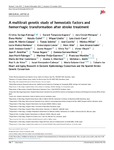A multitrait genetic study of hemostatic factors and hemorrhagic transformation after stroke treatment

View/
Use this link to cite
http://hdl.handle.net/2183/37337
Except where otherwise noted, this item's license is described as Creative Commons Attribution 4.0 International License (CC-BY 4.0)
Collections
- Investigación (FCS) [1293]
Metadata
Show full item recordTitle
A multitrait genetic study of hemostatic factors and hemorrhagic transformation after stroke treatmentAuthor(s)
Date
2023-12-15Citation
Gallego-Fabrega C, Temprano-Sagrera G, Cárcel-Márquez J, Muiño E, Cullell N, Lledós M, Llucià-Carol L, Martin-Campos JM, Sobrino T, Castillo J, Millán M, Muñoz-Narbona L, López-Cancio E, Ribó M, Alvarez-Sabin J, Jiménez-Conde J, Roquer J, Tur S, Obach V, Arenillas JF, Segura T, Serrano-Heras G, Marti-Fabregas J, Freijo-Guerrero M, Moniche F, Castellanos MDM, Morrison AC, Smith NL, de Vries PS, Fernández-Cadenas I, Sabater-Lleal M; Cohorts for Heart and Aging Research in Genomic Epidemiology Consortium; Spanish Stroke Genetic Consortium. A multitrait genetic study of hemostatic factors and hemorrhagic transformation after stroke treatment. J Thromb Haemost. 2024 Apr;22(4):936-950.
Abstract
[Abstract]
Background: Thrombolytic recombinant tissue plasminogen activator (r-tPA) treatment is the only pharmacologic intervention available in the ischemic stroke acute phase. This treatment is associated with an increased risk of intracerebral hemorrhages, known as hemorrhagic transformations (HTs), which worsen the patient's prognosis.
Objectives: To investigate the association between genetically determined natural hemostatic factors' levels and increased risk of HT after r-tPA treatment.
Methods: Using data from genome-wide association studies on the risk of HT after r-tPA treatment and data on 7 hemostatic factors (factor [F]VII, FVIII, von Willebrand factor [VWF], FXI, fibrinogen, plasminogen activator inhibitor-1, and tissue plasminogen activator), we performed local and global genetic correlation estimation multitrait analyses and colocalization and 2-sample Mendelian randomization analyses between hemostatic factors and HT.
Results: Local correlations identified a genomic region on chromosome 16 with shared covariance: fibrinogen-HT, P = 2.45 × 10-11. Multitrait analysis between fibrinogen-HT revealed 3 loci that simultaneously regulate circulating levels of fibrinogen and risk of HT: rs56026866 (PLXND1), P = 8.80 × 10-10; rs1421067 (CHD9), P = 1.81 × 10-14; and rs34780449, near ROBO1 gene, P = 1.64 × 10-8. Multitrait analysis between VWF-HT showed a novel common association regulating VWF and risk of HT after r-tPA at rs10942300 (ZNF366), P = 1.81 × 10-14. Mendelian randomization analysis did not find significant causal associations, although a nominal association was observed for FXI-HT (inverse-variance weighted estimate [SE], 0.07 [-0.29 to 0.00]; odds ratio, 0.87; 95% CI, 0.75-1.00; raw P = .05).
Conclusion: We identified 4 shared loci between hemostatic factors and HT after r-tPA treatment, suggesting common regulatory mechanisms between fibrinogen and VWF levels and HT. Further research to determine a possible mediating effect of fibrinogen on HT risk is needed.
Keywords
Fibrinogen
Hemorrhagic transformation
Hemostatic factors
r-tPA treatment
von Willebrand factor
Hemorrhagic transformation
Hemostatic factors
r-tPA treatment
von Willebrand factor
Editor version
Rights
Creative Commons Attribution 4.0 International License (CC-BY 4.0)
ISSN
1538-7933






